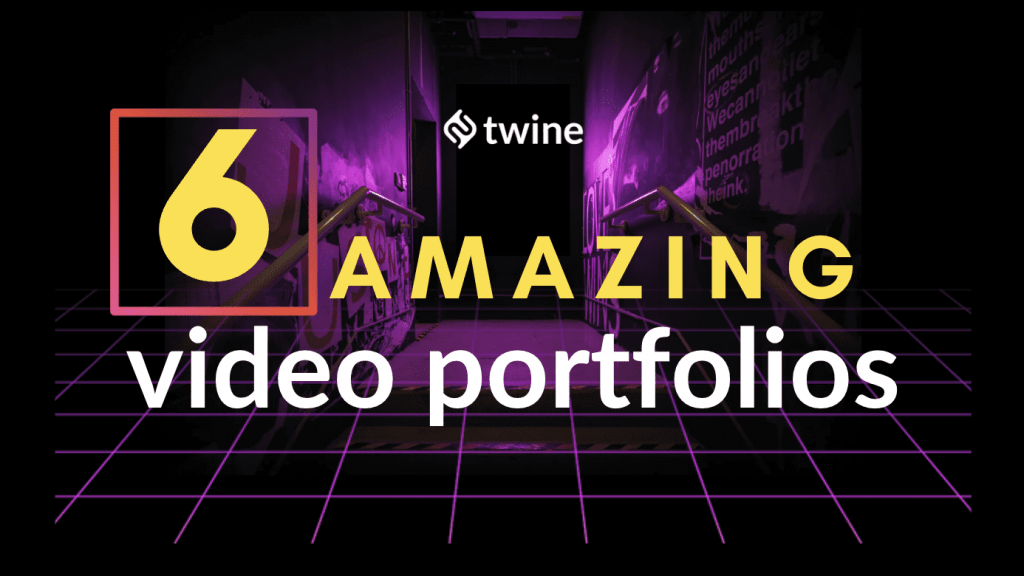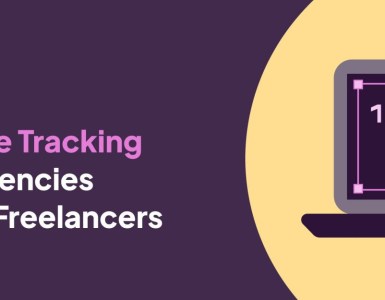
For more Portfolio Tools, check out the Freelancer Toolkit…
Video content is the most important medium on the internet. So, it’s no surprise that video portfolios are becoming all the rage.
The global market for film and video production was worth just shy of $325 billion in 2020, and is expected to grow to over $410 billion by 2030. Along with traditional filmmaking, businesses are using new video platforms like Instagram, to engage their viewers.
Let’s face it: video production is a fast-growing industry. There’s never been a better time to have the skills to make video content.
Businesses wanting to get ahead are needing people who know how to make great animations and videos.
So, to land work in the video industry, you’ll first need a video portfolio. You also need to decide how your video portfolio will look and where you’re going to host your samples.
Are you ready to get some priceless insights? Let’s get going.
Note: if you need help designing your video portfolios, or want an expert eye, visit Twine’s archive of Video Editors and Videographers.
Table of Contents
What is a Video Portfolio?
6 Steps to Creating an Amazing Video Portfolio
6 Video Portfolios to Get You Inspired
What is a Video Portfolio?

A video portfolio is a webpage or website where you can host samples of the best video content you’ve worked on.
Its’ purpose? To show prospective clients your talents, and impress them enough to land you gigs.
Think of this as the same as a media, or graphic design portfolio. Instead of some fancy typography skills, or excellent layer blending, the main attractions will be the videos you’ve had a hand in producing.
Whether you create content for social media, animations for educational videos, or even make films for motion-picture release – video portfolios are a must when you want to work freelance.
Not sure if you need to create a video portfolio for your work? If you’re a:
- Videographer
- Filmmaker
- Colorist
- Video editor
- Animator or motion graphic designer
- Content creator
- Director
- Producer
Or pretty much any other role with moving footage as the end result, you will need to have an online portfolio.
It’s super easy for your potential clients to access and for you to keep up to date and show how your video skills develop over time.
But how do you go about creating a video portfolio, you ask? Well, here’s our step-by-step guide.
6 Steps to an Amazing Video Portfolio

When you’re pitching to a production company, you want to have your best work ready to show them, rather than simply telling them what you can do.
Freelancing is a great way to be in control of your work, your income, and the work you do – you find your own leads and choose which gigs you pitch to.
Signing up with a site like Twine gives you access to businesses seeking creative skills – but you’ll need a portfolio to showcase your video skills to show them!
Here’s what you need to do to get your portfolio set up.
Step #1: Find your niche and target audience
The first thing you need to understand is your niche: what you’re able to do for the people you want to work with.
There are three key elements to defining your niche:
- Figure out what you’re good at doing
- Pair that with what you love to do
- Work out whether someone is willing to pay you for that thing
Once you know what you’re going to make, you need to focus on the third point. People willing to pay for your skills are your target audience.
To define your target audience, you should consider a few things. First, think about the work you’ve already completed. Then, figure out who your competition is. Finally, what value can you add to projects?
After figuring out what skills you’re offering, and who you aim to sell them to, you then need to show everyone what you’re capable of.
Step #2: Build your website

Having a website to show your video portfolio is hugely important – a simple showreel or highlights reel won’t do your work justice and there are so many awesome ways to present your talent.
There are four main ways you can build your online portfolio:
- Upload your videos to a public video-sharing platform like Vimeo or YouTube. It’s free, but you’ll have their branding on your best work.
- Use a video portfolio platform like Carbonmade – it’s a simple way to host your portfolio when you’re starting out. We’ll look at an example of this in the next section.
- Build your own custom website using WordPress. You’ll need to get to grips with themes and plugins or pay someone to design your site for you.
- Create a video website using templates from sites like Squarespace, Wix, or Uscreen. Your site will be fully branded and you can even sell other content through your site.
Moving on to what you need to include on your new video website.
Step #3: Show work variety and showcase video highlights
As your career has developed, you’ve probably worked on a whole range of video content that you want to show off in your video portfolios.
When you’ve worked on shorts, features, or series for places like:
- Large corporations
- Small non-profits
- Musicians
- Mid-sized brands
You want to make sure that’s clear in your video portfolio.
Be picky, though.
You don’t want everything from your back catalog in your portfolio, just the best, high-quality work that you’ve built your reputation on.
No matter if you’re working with a freelancer platform like Twine or running your own email outreach campaign, you want to show your best bits that fit your niche.
The next step is coming right up.
Step #4: Include behind the scenes video content

You want to let your prospective clients and collaborators see your style of work as well as your output.
A simple but effective way to do this is to include behind-the-scenes footage.
This behind-the-scenes video helps people understand what a day working with The Agency Arizona might look like.
Behind The Scenes | Test Shoot
Show your working methods, how you rig lighting, the way you give actors direction, or how you frame a shot with a short example of your working pattern.
Let’s keep going.
Step #5: Include a strong CTA
Once the person you’re pitching to has finished watching your content, they need to know what to do next.
This is where a call-to-action or CTA comes in.
Use the end screen of your video to ask for something from the viewer, such as:
- Sending you an email
- Booking a call with your calendar link
- Completing the contact form on your website
Or whatever else will help move them to the next step of commissioning your work.
There’s one last element of your video portfolio to add.
Step #6: Showcase personal footage to raise brand awareness

People hire people.
They don’t hire a list of skills or achievements – they hire other humans, who they want to spend time with at the watercooler. Because of this, it is crucial that you make your personality known within your video portfolio.
You don’t necessarily have to be bubbly and fun (faking a personality is about as helpful as not showing one at all – people can spot a fake). If you work on hard-hitting documentaries or corporate communications videos, for instance, you need to show how you’re suited to this work.
This is your chance to create your brand and tell people what you’re all about. No fuss, a quick 1- or 2-minute explainer about you should do the trick.
Are you ready for some creative inspiration? Good. Now, we’re going to check out 6 jaw-dropping, show-stopping video portfolios, to get you in the mood to create…
6 Video Portfolios to Get You Inspired
Example #1: Khoa Lê
Khao Lê is a filmmaker, stage director, and video designer based in Canada.
Although they’ve worked on a range of projects, everything is neatly packed for the viewer, in order not to overwhelm. For example, they have their best work categorized under art and commercial samples. Your client may be looking for one element, theme, or design choice, for their project – so, make it easy for them.
The site is super dynamic, with headings and other creative elements moving as you scroll through the body of work. It’s also elegant and unfussy, leaving the video the star of the show: which is what you want.
Example #2: Secret Wood
Secret Wood is a video collective, working together to use technology to produce videos.
Once again, the videos are the main attraction here, seen with a simple monochromatic layout. Colorful clips pop out from the dark, in collectives of only 3 or 4. Because of this, the viewer’s gaze isn’t tired, and they feel they can scroll deeper into the portfolio.
There’s also a handy mechanism that you could ask a web developer to install for your own video portfolio. When one of the portfolio videos ends, a screen appears, inviting you to watch more of their productions. They’re effectively keeping any potential clients engaged with their work, spending less time looking at other candidates…
Example #3: Jacob McKee
Jacob McKee specializes as a colorist for music videos, movies, and commercials.
We’ve already looked at a couple of sites that keep it simple, but McKee’s video portfolio takes minimalism to a beautiful extreme.
He only hosts six videos on the site – that’s right, just 6. Think you could minimize your portfolio to your 6 greatest works? The positives of this, are that a prospective client knows that these are going to be the absolute best of what he can offer.
With the increase in content and attention fatigue, maybe a minimalized, no-fuss, portfolio is what’s needed?
Example #4: Ava DuVernay
Here’s a titan when it comes to video portfolios. Ava DuVernay is an award-winning director, writer, producer, and film distributor.
Yes, they’ve worked on impressive projects – with impressive individuals (yes, we see you Jay-Z) – but the presentation of the work is what holds its own. This video portfolio is presented as a work of art.
Video portfolios that have a tiled presentation bear a nice contrast, as they accentuate each thumbnail. If your specialty is within still-image photography, and cinematography, this is certainly something to take advantage of.
Once hovered over each thumbnail, a simple tile is revealed, providing more information per project.
Similar to Khoa Lê, she’s also made the addition of adding awards and acclaim section, further highlighting her expertise. For all that she’s achieved, there is a piece featured. That’s one surefire way to impress those potential clients!
Example #5: Justin Kleiner
Justin Kleiner, on the other hand, isn’t a traditional filmmaker. He is a visual artist and musician, which reflects heavily in the format of his portfolio.
Instead of displaying a series of thumbnails of video projects, Kleiner cleverly features his latest motion graphic project at the center stage of his homepage.
Clients are instantly given an insight into the talented artists’ potential, as well the styles and designs he has worked on in the past. Not only that, but beneath the title, you can see references and awards that have been cleverly added to the design piece.
The site also has a specific page dedicated to each video. Because of the extra room, Justin is able to offer some information about the concept behind each video, giving insights into his creative process.
For anyone who might want to work with him, this is a super valuable and detailed bonus. Justin spares no stops in guiding the client towards the best route possible – a hire.
Example #6: Jacquelyn Evans
When it comes to video portfolios, this example is a star. Jacquelyn Evans is an animation student based in Canada and has already created her video portfolio site.
As video portfolios go, this one is simple, yet effective. The navigation bar at the top shows anyone wanting to hire her exactly what skills she brings to the table.
As you can see, using a design of yours to dominate the home screen is popular with many animators and motion graphic designers. To encapsulate her vision, she’s used Carbonmade, the portfolio hosting site (that we talked about earlier), however, there are plenty of portfolio-hosting sites available on the web.
Or, if you’re in the market for a truly spectacular, 100% custom video portfolio, you can always consult expert web designers.
And that’s it! Those are all the examples of video portfolio sites we have for you. Have you been inspired? Thrilled? Let’s wrap this up.
Wrapping up
Video portfolio sites aren’t just for established names.
Even as a freelance beginner you can create a video portfolio, and then build it up once you gain skills and experience worthy of showcasing. No matter the stage of the video production workflow, or the number of projects you’ve worked on, a video portfolio is needed for a strong career.
Looking for more design tips for your portfolio?
Check out Twine’s guide to animation portfolios, as well as our masterclass on beefing up your portfolio for more ideas and inspiration.
Ready to get hired? At Twine, we have dozens of top-quality jobs being posted each and every day. From design to marketing, development to copywriting – there’s a job ready for your skills. Join the marketplace of diverse creative talent here.



